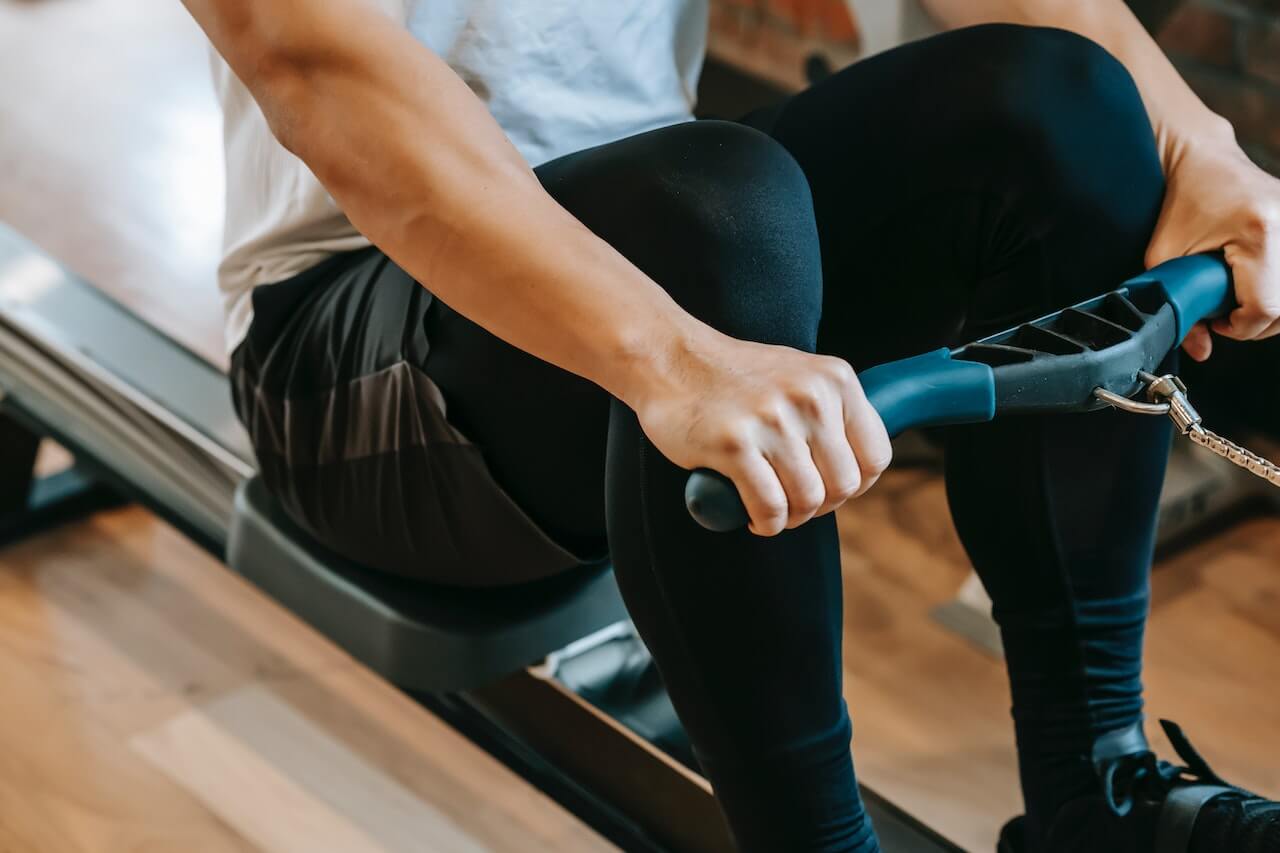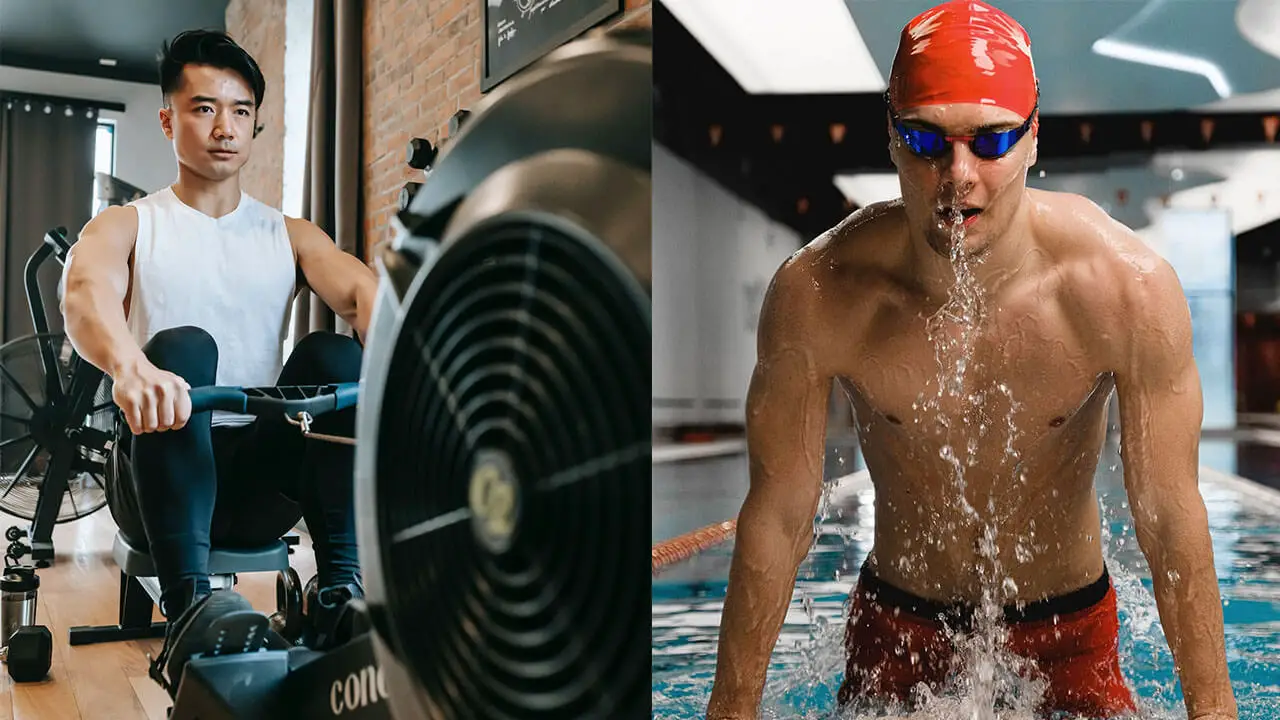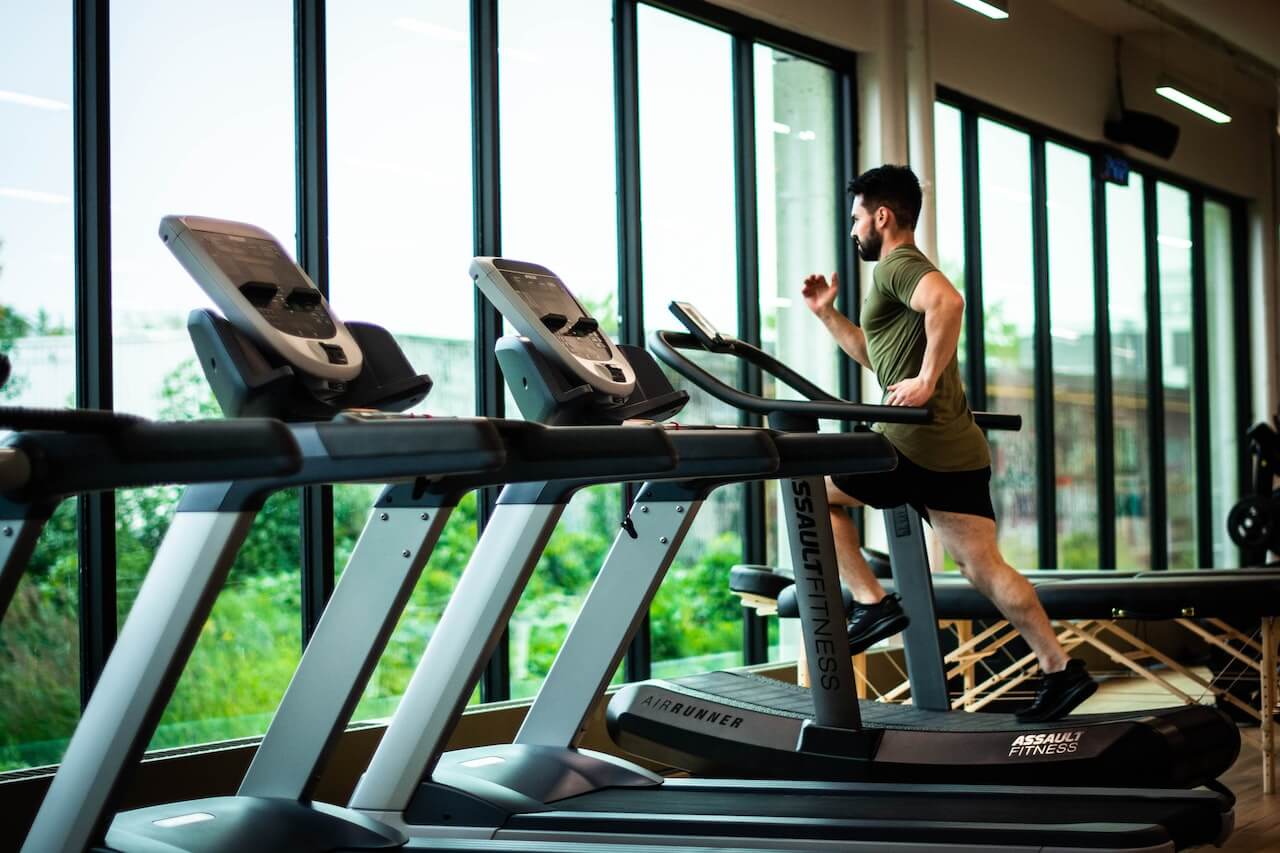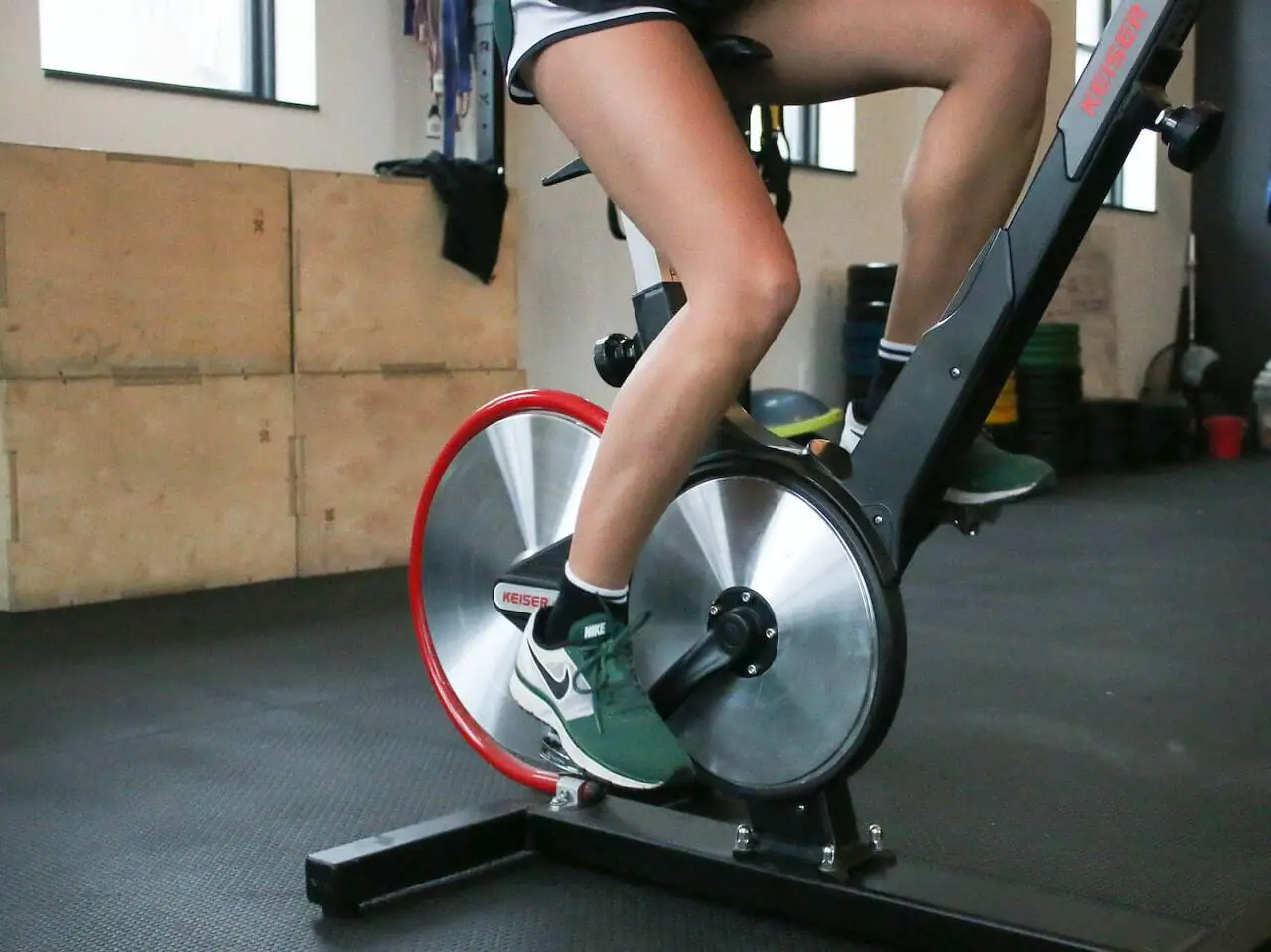Swimmers know that finding the perfect cross-training exercise is crucial for improving performance and preventing injury. That’s where the rowing machine comes in; it could be the answer you’ve been looking for.

Rowing machines help you work on your “catch” and build the essential leg and arm muscles needed for swimming, all while maintaining a high cardiovascular and rhythmic workout. It closely mimics swimming’s muscle activation, improving stroke power and endurance. Moreover, it’s a low-impact exercise, aiding in injury prevention and rehabilitation for swimmers.
But don’t just take our word for it; let’s dive into why rowing machines are so beneficial for swimmers and how they can complement your training routine.
Rowing Machines and Swimming

Benefits for Swimmers
Rowing machines can be a fantastic addition to a swimmer’s dryland training routine. Besides being a low-impact cardio workout, indoor rowing can also provide the following benefits:
- Full Body Workout: Like swimming, rowing is a full-body workout that targets a variety of muscle groups. It works your legs, core, and upper body, closely mimicking the muscle activation pattern in swimming. This comprehensive muscle engagement can help improve overall strength and endurance in the water.
- Cardiovascular Conditioning: Both rowing and swimming are excellent for cardiovascular health. Rowing helps to improve heart function and lung capacity, contributing to better stamina and performance during swimming.
- Aerobic and Anaerobic Training: Rowing offers both aerobic and anaerobic conditioning depending on the type of workout you perform. High-intensity interval training on a rowing machine can help improve anaerobic capacity, while steady, long-distance rowing sessions can enhance aerobic endurance. Both these fitness components are essential for competitive swimming.
- Low-Impact Exercise: Rowing is a low-impact exercise that’s easy on your joints, reducing the risk of injury. This makes it a great cross-training option for swimmers, who often need to balance their high-volume training in the water with safe, effective exercises on land.
- Flexibility and Mobility: Rowing promotes flexibility and mobility, particularly in the hip joint, which can contribute to a stronger and more efficient kick in swimming.
- Core Strength: A strong core is vital for swimming, helping to stabilize your body in the water and transfer power effectively through your stroke. Rowing is an excellent core workout, engaging your abs and obliques with every stroke.
- Injury Prevention and Rehabilitation: Rowing allows you to maintain fitness while recovering from swimming-related injuries. It is an effective way to rehabilitate injuries, especially shoulder injuries, common in swimmers. Also, rowing can serve as an excellent preventive measure, promoting balanced muscle development to avoid overuse injuries.
Muscle Groups Targeted
Indoor rowing targets various muscle groups essential for swimmers, including:
- Quadriceps: Rowing helps to build strong quadriceps, vital for proper kicking and overall lower-body strength in the water.
- Core: A crucial element for maintaining stability and effective swimming technique, your core plays a significant role in both rowing and swimming.
- Arm muscles: The pulling motion during rowing helps to develop arm muscles such as biceps and triceps, useful for swimmers who need powerful strokes.
- Back muscles: Rowing engages your lats, rhomboids, and other back muscles, which are crucial for efficient propulsion in the water.
Techniques and Tips for Using Rowing Machines
Proper Rowing Technique
To get the best results as a swimmer using a rowing machine, you must first learn the proper technique. Here is a step-by-step guide on how to properly perform a row:
- Start by sitting tall on the machine with your feet securely strapped in and your knees bent.
- Grasp the handlebars with an overhand grip, slightly wider than shoulder-width apart.
- Engage your core and maintain a straight back, and shoulders relaxed.
- Moving smoothly, first push your legs back, engaging your quads and glutes.
- As your legs straighten, lean back slightly and use your upper body to pull the handlebars toward your chest, between your ribs and your navel, engaging your latissimus dorsi and other back muscles.
- To return to the starting position, extend your arms, lean forward from your hips and bend your knees.
Warming Up
Before starting your rowing session, take a few minutes to warm up, preparing your muscles and joints for the exercise.
Start by doing some dynamic stretches targeting your hip flexors, glutes, quads, and hamstrings. You can also do a light cardio warm-up such as jumping jacks or jogging in place to increase your heart rate.
Pace and Stroke Rate
Finding the right pace and stroke rate is essential for an effective rowing workout. Pace refers to the speed at which you complete each stroke, while stroke rate is the number of strokes per minute (spm).
The ideal pace and stroke rate will vary depending on your goals, fitness level and experience, but a good starting point for most swimmers is to aim for a 1:2 ratio between the drive phase (when you push back) and the recovery phase (when you return to the starting position).
Aiming for a lower stroke rate such as 20-22 spm will help you focus on improving your technique and efficiency, while gradually increasing the stroke rate over time will help to develop aerobic fitness and stamina.
To measure your progress, you can use a Concept2 rowing machine which tracks your pace and stroke rate, allowing you to easily adjust and optimize your workouts.
Comparing Rowing Machines and Other Cardio Exercises
Why should you pick a rowing machine over other forms of dryland cardio? In this section, we’ll compare the rowing machine to its rivals the treadmill and stationary bike.
Rowing vs Treadmill

Rowing machines provide a unique, full-body workout that engages both your upper and lower body muscles.
Unlike the treadmill, which primarily focuses on your legs and cardiovascular system, rowing incorporates pushing and pulling motions to work your lower and upper-body muscles simultaneously.
- Cardiovascular Benefits: Both rowing and treadmills provide excellent cardio workouts, but rowing machines can offer a more efficient workout in less time by engaging more muscle groups at once.
- Calorie Burn: While running on a treadmill may burn more calories per minute, rowing machines can still contribute to significant calorie burn and weight loss, especially when combined with other exercises.
- Impact on joints: Treadmills can be hard on your knee joints, whereas rowing machines are low impact and gentler on your body. You should still learn the proper form, however.
Rowing vs Stationary Bike

Another popular cardio option is the stationary bike. How does it compare to rowing machines?
- Muscle Engagement: Stationary bikes primarily focus on your lower body, specifically your quadriceps. On the other hand, rowing machines provide a more balanced workout by engaging both your lower and upper body muscles.
- Cardiovascular Benefits: Both stationary bikes and rowing machines offer excellent cardio workouts that strengthen your heart, lungs, and cardiovascular system. However, rowing machines might edge out stationary bikes in terms of overall calorie burn and workouts that engage multiple muscle groups.
- Impact on joints: Similar to rowing machines, stationary bikes are also low impact and gentle on your joints.
To sum this section up, treadmills and stationary bikes can also offer solid cardio workouts, but rowing machines may provide more efficiency and a well-rounded workout experience by also training your upper body.
For these reasons, rowing machines are one of the better forms of dryland cardio that has plenty of carryover into swimming.
Choosing the Right Rowing Machine
Types of Rowing Machines
Are you sold on training with a rowing machine? Thinking about getting one of your own? Then you need to know what to look for in a rowing machine.
There are several types of rowing machines available on the market, each offering a different feel and level of comfort for your indoor rowing experience. Common types include:
- Air resistance rowers: These rowing machines use a fan to create resistance as you pull. Examples like the popular Concept2 rowing machine offer a smooth and efficient workout.
- Magnetic resistance rowers: A magnetic rowing machine provides a quieter and smoother rowing experience. The resistance is adjusted by moving a magnet closer or further from the flywheel.
- Water resistance rowers: If you’re looking for a more realistic rowing experience, water resistance rowing machines closely mimic the feel of rowing on water.
- Hydraulic resistance rowers: These rowing machines use hydraulic pistons to create resistance, making them compact and ideal for those with limited space.
Factors to Consider When Buying
To choose the best rowing machine for your needs, consider the following factors:
- Comfort: Make sure the seat, handle, and footrests on the rower are comfortable and adjustable to fit your body.
- Space: Some rowing machines, like hydraulic resistance rowers, are more compact and can be folded up for easy storage. This could be important if you have limited space in your home.
- Price: Rowing machines can vary in price from a few hundred dollars to several thousand. Consider your budget and research which features are most important to you.
- Fitness level: Some rowing machines have more advanced features and higher resistance levels, so think about your current fitness level and goals when choosing a rower.
Quality and materials: The build quality and materials of a rowing machine can impact its durability and performance. Look for sturdy, lightweight materials that can withstand consistent use.
Preventing Injuries and Staying Safe
Common Rowing Injuries
Even though rowing is a low-impact exercise, if you do any activity with incorrect form for long enough, you will get injured. Rowing machines are no exception.
The key areas where rowers often experience issues include the back, shoulders, and joints. In particular, some people may experience back pain, shoulder pain, or even rotator cuff injuries.
As a swimmer, you must be proactive in preventing such injuries, as they can significantly affect your ability to perform in the water.
Safe Rowing Practices
To minimize the risk of injury, consider the following safe rowing practices.
Focus on proper technique: Maintaining correct form while rowing is critical. Not only does it reduce the strain on your joints, but it also helps to build the necessary arm muscles and strength required for swimming.
Gradually increase intensity: To avoid overwhelming your body and putting excessive pressure on vulnerable areas like your shoulders, start with a gentle resistance level and gradually increase the intensity as your body adapts. This approach will allow you to build up your strength while minimizing the risk of common rowing injuries.
Warm-up properly: Before jumping on a rowing machine, it’s essential to warm up your muscles and joints to prevent injury. Engage in some dynamic stretches or light cardio to get your blood flowing and ensure your body is ready for the demands of rowing.
Listen to your body: If you experience any pain or discomfort while rowing, don’t ignore it. Listen to your body’s signals and adjust your technique or intensity as needed. If the pain persists, consult a medical professional for further guidance.
Incorporating these practices into your rowing routine can significantly reduce the risk of injury and help you get the most out of your rowing workouts. Remember, by taking care of your body during your strength and conditioning sessions, you’re also setting yourself up for success in the pool.
Frequently Asked Questions
How many calories does rowing burn compared to swimming?
Swimming vigorously can burn anywhere from 300-420 calories in 30 minutes. Rowing vigorously for 30 minutes can burn anywhere from 255-440 calories. They both burn similar amounts of calories at similar intensities.
Do rowing machines work the same muscles as swimming?
While the movements are different, rowing and swimming engage many of the same muscle groups, making rowing machines a good complement to swimming training.
How often should a swimmer use a rowing machine?
This depends on individual fitness goals and training plans. Generally, incorporating rowing sessions 1-2 times a week can provide significant benefits.
Can rowing help improve my swimming speed?
Yes, the strength and endurance gained from rowing can contribute to more powerful strokes and better overall swimming speed.
Can I only train on a rowing machine and still improve my swimming?
While rowing is a great cross-training method, it can’t entirely replace swimming-specific training. It’s best used in conjunction with regular swimming workouts.
Is rowing a good exercise for recovering from swimming injuries?
Yes, because rowing is a low-impact activity, it’s often a suitable exercise during injury recovery. However, always consult a healthcare provider or physical therapist before starting a new workout regimen when injured.
What kind of rowing workouts should I do to improve my swimming?
A mix of long, steady-state sessions and high-intensity intervals can mimic the energy demands of swimming, aiding both endurance and sprint performance.
Which type of rowing machine is best for swimmers?
The choice of rowing machine largely depends on personal preference. Air, magnetic, and water rowers all provide effective workouts, but they differ in terms of resistance, feel, noise, and cost.
Do professional swimmers use rowing machines for training?
Yes, professional swimmers incorporate rowing into their training routines for its full-body workout and cardiovascular benefits.
How should I maintain proper form while using a rowing machine?
Proper form involves a strong but smooth push with the legs, leaning back slightly with the core engaged, and then pulling the handle towards the chest. Always remember to reverse this motion smoothly when returning to the start position.
Are there any risks or downsides to using a rowing machine for swimmers?
Improper form or overuse can lead to back or shoulder injuries. Always start slow, prioritize technique, and gradually increase the intensity and duration of workouts.
Sources:
- https://www.health.harvard.edu/diet-and-weight-loss/calories-burned-in-30-minutes-for-people-of-three-different-weights
- https://www.swimmingworldmagazine.com/news/using-the-concept2-rowing-machine-in-swimming-training/
- https://www.self.com/story/is-rowing-strength-or-cardio
- https://www.healthline.com/health/benefits-of-rowing-machine
